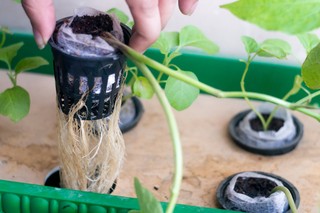What is root rot: How to identify, treat, and prevent

Water…it seems like a good thing, right? Our plants need it to grow so one would think that giving your container plants a little extra wouldn’t be problematic. Unfortunately, overwatering houseplants, herbs, and other container plants is one of the biggest downfalls and problems homeowners face. Too much water in the growing media leads to adverse growing conditions, with root rot taking the stage as the most dangerous.
Root rot is the number one silent killer of container plants, and often reaches fatal stages before it’s even noticed. This is why it’s so important to understand what exactly it is, and then how to identify it, treat it, and prevent it to keep your plants healthy and thriving.

The enthusiast's guide to herbs
We’re proud to present our new e-book, The Enthusiast’s Guide to Herbs! Learn everything you need to know about growing and caring for herbs indoors, including in-depth info cards for the 35 most commonly grown herbs.
Click the link below to find out more!
What is root rot?
Simply put, root rot is the decay and rot of plant roots caused by a lack of oxygen in the growing substrate. Just like humans, the submersion of roots in water with little oxygen causes them to suffocate and drown.
Low oxygen also triggers the overgrowth and multiplication of fungi that naturally occur in the soil such as Pythium, Phytophthora, Rhizoctonia, Botrytis, Alternaria, or Fusarium. Once colonies begin growing they move into the weakened roots, infecting the plants.
After infection, the roots begin to perish, unable to take in oxygen, water, and nutrients needed for growth and the plant quickly dies.

What does root rot look like?
When root rot shows up in plants, it is often mistaken for other problems because of the symptoms it exhibits, and the similarity of these symptoms to other maladies.
Underwatering
People are quick to think their plants are suffering from a lack of water when in reality the problem stems from being overwatered. The visible symptoms of water stress - whether too much or too little - are similar, especially since leaves will begin to wilt in both cases.
This is where one of the biggest problems comes in. The assumption that wilt equates to underwatering results in homeowners giving their houseplants more water, further exacerbating the problem of too much water and too little oxygen in the root zone instead of fixing it.
Nutrient Deficiency
The second misconception arises when homeowners assume the symptoms their plant is displaying is related to a nutrient deficiency. If the soil feels wet to the touch, the plant is getting enough sunlight, and there aren’t any physical signs of insect pests, people tend to think the plant is lacking nutrients.
Yet again, this is where the problem comes in. Many people growing houseplants indoors choose to feed their plants with water-soluble fertilizers, the kind they mix in water and add to the soil. So they mix up a batch and give their plants a hearty dose. This adds extra water to an already waterlogged growing media and the problem of root rot is only fueled further.
Symptoms of root rot
The challenge with root rot is that it often goes unnoticed because it occurs in the root system, beneath the soil surface and out of your sight. Once observed in the foliage the disease is usually severe.
The first visible symptom shows itself on the plant roots, as the fungal infection causes them to turn brown or reddish and mushy instead of their healthy firm, white nature with numerous feeder roots. As root rot progresses leaves begin yellowing, wilting, or drooping and then become mushy as well. Once symptoms are visible in the leaves the problem may be past the point of rectifying, endangering the entire plant.
In extreme cases when conditions are perfect, cool temperatures and saturated soil, root rot can kill a whole, healthy plant in just a couple of weeks.

Is root rot contagious?
Unfortunately yes, root rot can be transferred from one plant to another. The fungal spores are airborne and can also be transported by insects as well as dirty gardening tools.
Garden plants are more susceptible to the transfer of spores from one plant to another because of their closer proximity, increased air movement outdoors, and insects traveling from plant to plant. Indoor-grown container plants spread the root disease less frequently, but it still happens, especially if you are overwatering all of your plants.
What causes root rot
There are a handful of factors that come together to cause root rot, all of which are interconnected.
- Overwatering – Root rot, as well as other root diseases start when plants are overwatered, and the roots set in waterlogged, wet soil.
- Poor drainage – This is compounded when the growing media doesn’t drain well, allowing the excess water to occupy all of the pore space between the growing media. Poor drainage is exacerbated when a container doesn’t have adequate drainage holes, the potting soil is compacted, or the incorrect substrate is used to grow your plants in.
- Lack of oxygen – When the growing substrate is consistently overwatered, water fills in all of the pore spaces of the growing media pushing out oxygen. Without oxygen, or when oxygen concentrations in the soil are low, physical processes such as nutrient and water uptake and plant respiration all halt, to the detriment of the plant.
- The proliferation of fungal growth – Fungal spores naturally occur in the soil, and in commercial potting mixes. When there is an appropriate balance of water and oxygen in the root zone their numbers stay low, posing little risk to the roots. However, when water levels increase dramatically causing oxygen levels to drop, they proliferate, especially during the cooler winter months and quickly wreak havoc on plants.
How to treat root rot
The most effective treatment for root rot disease is replanting the affected plant in fresh soil.
Repot the plant, if caught soon enough. Remove as much of the infected soil by gently shaking it from the roots and then repot the plant in fresh, clean potting soil.
You can add a root treatment containing beneficial mycorrhizal species, or dust the healthy roots with sulfur powder or cinnamon - a natural fungicide - to help prevent reinfection.
Beneficial mycorrhizae work by creating a hostile environment for the unwanted bacteria and fungi, killing them before they can infect your plants. The sulfur acts by acidifying the soil, making certain nutrients less available and in turn limiting the pathogen’s food source.
If root rot has spread significantly your safest option may be to discard the entire plant and start over. You can try to dissect the infected plant using sterilized cutting tools, keeping only the healthy portions and transferring them to fresh soil. If the entire root system is compromised, take stem or leaf cuttings from the healthy foliage and try to propagate a new plant.

Preventing root rot
Without a doubt, one of the best measures is knowing how to prevent root rot and working hard towards prevention instead of having to quickly treat the problem if it arises.
Good drainage is key to preventing root rot, maintaining an appropriate ratio of water and oxygen in the root zone.
- Use the appropriate growing media for your plant type. You should never use regular garden soil for container plants. It compacts easily in containers, pushing all of the oxygen out of the pore space in the root zone. If you have plants that are more susceptible to root rot, opt for a growing media that has higher levels of coconut coir, vermiculite, or perlite in it to promote drainage.
- Make sure there are drainage holes in the bottom of your containers. If your pot doesn’t have them, you may be able to add them yourself using a cordless power drill. Just be careful that you use the appropriate drill bit. Plastic and metal containers are easy to work with; terra cotta and clay pots can crack if you don’t use a masonry drill bit.
Sometimes it’s necessary to use a container that doesn’t have any drainage holes, nor can any be added. In this case, you will want to create a cachepot, to allow drainage. Pot the plant in a container that is slightly smaller in diameter than your non-draining one. Place something on the bottom of the bigger container like stones and then set the smaller one inside it. This space between the bottoms of the two pots allows the smaller container to drain into the larger one.
- Forego the old recommendation to line the bottom of your container with rocks or pebbles to create a drainage layer. Research has shown this actually inhibits drainage instead of encouraging it. Water moves downward through the soil via gravity but will stop moving if it encounters a layer of rocks or small tones. The entire potting mix must fill with water before it will percolate into the “drainage” layer, rendering the layer problematic instead of useful.
- If you have a saucer or other catch basin under the container to collect excess water as it drains out, make sure to empty it every time you water your plants. Never let your plant sit in this standing water.
- Lastly, the most important aspect of prevention is to water your plants appropriately. For many plants, this means letting the top of the growing media dry out before you water the plant again. This is especially important during the cooler winter months when the plant is dormant and its growth has slowed.

Root rot in hydroponics
Chances are, you’re wondering how plants can grow in hydroponics systems, where the roots can live completely in water, with no soil, and not constantly succumb to root rot?
The truth is, root rot is still problematic in plants that are grown hydroponically and must be carefully watched for. Hydroponics systems center around nutrient solutions being fed to the plants, this results in an almost constant movement of water through the root zone of plants. This movement encourages oxygenation of the solution, delivering oxygen to the roots.
When water is left stagnant and the oxygen is depleted from it, plants can then experience root rot similar to when grown in soil.

Join our email club—get printable info cards free!
Sign up to receive our newsletter and get access to 10 printable plant info cards from our e-book for free. Also receive:
- $4 discount code for our Guide to Herbs e-book
- Semi-weekly plant inspiration & bite-size tips and tricks
Conclusion
Root rot is a serious root disease in plants, container-grown ones especially. When plants are overwatered, or there is improper drainage, waterlogged soil can encourage the growth of soil-borne fungi that quickly moves into the roots, killing plants. Prevention is the best management approach and includes making sure the root zone drains freely and plants are not overwatered. Treatment is possible but once symptoms appear in the parts of the plant above the soil surface, it may be too late to ameliorate the damage already done.
